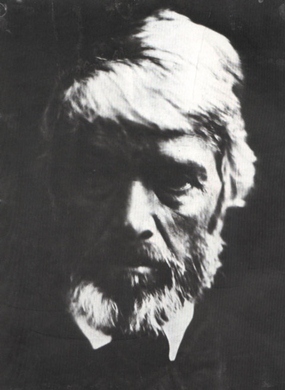A friend of mine is doing a photography course by correspondence, and the latest test is portraits. A very important subject, since portraits of people represent around 90 percent of all photographs. With portraits, names like Irving Penn and Richard Avedon come immediately to mind. Many portraitists, especially as photo technology improved, have produced spectacular portraits with dramatic flash strobe lighting, or have used amazing props to give the photo just that little something extra, but was that really needed? I would suggest No!
Look at this week’s photograph, that of the eminent historian Thomas Carlyle. It was taken in 1867 and is ranked as one of the most powerful portraits in the history of photography. I have written about this before, but it stands repetition. This is photography with a capital P!

Now look again – technically it is imperfect. There is blurring of the image, but when you realize that the shutter was open for probably around three minutes, then you can see why. The sitter could not possibly remain motionless for that period of time.
The dynamics of this shot come from the very first principles of photography – painting with light. It is not the subject – it is the way you light the subject. The light is falling on the sitter almost from the side and slightly above. One eye is partially lit and the other in shadow. The hair and beard show up strongly. The photo is totally confrontational.
Analyze further. If the face had been front lit, and both eyes, the nose and the mouth were all clearly visible then there would be no air of mystery. The dark shadow areas of the photograph have made you look further into it. You begin to imagine what the features were like. You also begin to imagine what the person was like. You have just experienced the “perfect” portrait.
The shot was taken by Julia Margaret Cameron (1815 – 1879), a British lady who had been raised in India, in the days of the British Raj. Surrounded by servants, she had never had to do anything for herself, and yet, in her late forties she took up the new-fangled notion of photography. This was not the age of the point and shoot simplicity we enjoy today. This was the age of making your own photographic plates by painting a mixture of chemicals all over it – chemicals you mixed yourself – exposing the plate in a wooden box camera and then fixing the negative in more chemicals and finally making a print.
It was the 29th of January 1864 when Mrs. Cameron finally produced her first usable print. She had made the exposure at 1 p.m. and in her diary recorded the fact that by 8 p.m. she had made and framed the final print. (And you think you are doing it tough if you have to wait two hours, instead of one!)
However, she would not have managed to photograph so many of the notables of the era had it not been for her next door neighbor, the Poet Laureate, Alfred Lord Tennyson. After Tennyson saw his portrait he persuaded his eminent friends to sit for her as well. Most of these portraits were different from the Thomas Carlyle photograph in that they were taken in profile. Mrs. Cameron felt that the innate intelligence could be more easily seen in the profile and this may have been the result of the influence of the quasi-science of Phrenology, whereby your cranial bumps showed your true talents, which was all the rage at that time!
Julia Margaret Cameron contributed to photography by showing that it is the eye of the photographer that dictates the photograph, not the “smartness” of the equipment.
So you can stop reading the photographic magazines to see if you should buy the latest offering with 300 megapixels and one zillionth of a second shutter speed and dedicated flash power for up to three kilometers and just go out and take photographs with what you have got. Look at what is in front of you and “make” your own photographs “work” for you. Thus endeth the inspirational lesson. Thank you Mrs. Cameron. Class dismissed!




